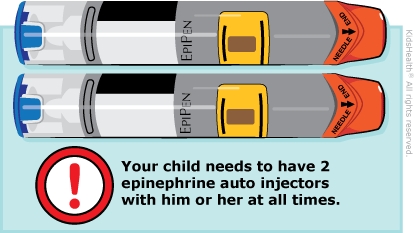Your child was stung by an insect and had an allergic reaction. If your child has another insect sting, the reaction could be even more serious. A serious allergic reaction is called anaphylaxis. Anaphylaxis can be deadly and needs treatment right away. A child with anaphylaxis may have one or more of the following:
- swelling of the face, eyes, throat, feet, hands, or inside of the ears
- hives (raised welts on the skin) over much of the body
- trouble breathing that can include shortness of breath, a hoarse voice, a wheeze, a cough, or a tight feeling in the throat
- stomach problems like belly pain, vomiting (throwing up), or diarrhea (watery poop)
- a dizzy feeling (which could lead to passing out)
Anaphylaxis is treated with epinephrine injection. In case your child has another allergic reaction, keep 2 epinephrine auto injectors (brand names EpiPen®, EpiPenJr®, and Adrenaclick®) with your child at all times. The health care provider gave you a prescription for this medicine.

How can I help my child avoid getting stung again? To help your child avoid insect stings, teach him or her to:
- Stay away from beehives, insect nests, and other areas where insects like to be, such as flower beds.
- Be calm and quiet around stinging insects. Back away slowly.
- Check for insects in drink cups, cans, and straws when outside.
- Wear shoes when outside.
- Wear long pants, socks, and closed-toe shoes when walking or playing in grassy areas or fields. Wear gloves and long sleeves when gardening.
- Use unscented hair and body products, and do not wear perfumes or brightly colored or flowered clothing. They attract insects.




